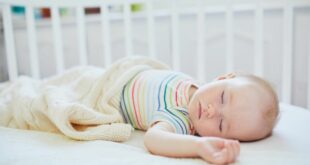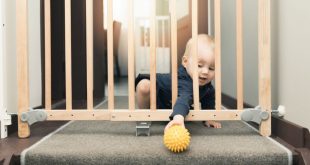What to Buy for Baby
You’re bringing baby home. What are the must-haves?
Every expectant mother wants to be prepared with all the essentials for the baby. Today, there is the convenience of baby registries to let friends and family know what she needs for the new baby. Babies “R” Us offers a “Must haves!” checklist consisting of five main categories, 19 sub-categories and 138 listings under the sub-categories! How do you distinguish between what you really need and the stuff that is cute now, but in six months will clutter your floor, need dusting or will be forgotten about in the back of the closet?
Let’s cover the basics.
Newborn babies know when they are tired, wet or hungry. They don’t know what a combination crib CD player/aroma therapy/nightlight with surround sound is, so if they don’t have one, they won’t miss it.
Babies need food, a place to sleep, clean diapers and love. Beyond that, everything is technically extra. Which doesn’t mean there aren’t things that can make life easier.
The Nursery
Every mother envisions a beautiful nursery with coordinating bedding, window treatments, rugs and accessories. But take a look at the big picture when outfitting the nursery. A six-piece bedding set includes a comforter, bumper pad, fitted sheet, dust ruffle, a valance and diaper stacker. At Babies “R” Us, prices range from $149.00 to over $200.00. The baby really just needs fitted sheets, a bumper pad and if you want to be fancy, a dust ruffle. Purchased separately, these three items, in basic colors or patterns can cost as little as $35.00.
Babies don’t need comforters. In fact, the Consumer Product Safety Commission recommends parents consider using a sleeper instead of a blanket or comforter to reduce the risk of SIDS (Sudden Infant Death Syndrome). So, unless you plan on using the comforter for a wall decoration, skip it and splurge on something you’ll get a lot more use out of.
Such as a good stroller—which a newborn won’t need from Day One.
Cradles and bassinets are optional. When my first son was born a family member lent us a bassinet. Matthew wouldn’t sleep in it for anything. He preferred his crib. The bassinet became a fancy place to store his blankets. Other mothers I know loved having the baby in their room and their babies slept fine in the bassinets. So crib v. bassinet? It’s a personal choice.
Without question, some items can make life in the nursery easier. Newborn babies are notorious for leaky diapers and spit up. Waterproof pads or sheet savers can be a lifesaver. These inexpensive items can keep you from having to change the sheets at 2am, 4am and again at 6am.
Another convenience item is a wipes warmer. No one likes something cold and wet on her tush in the middle of the night. Use a nice warm wipe and baby may be less startled and fall back to sleep easier.
Other items for day-to-day care include baby soap, baby shampoo, petroleum jelly, diaper wipes, baby nail scissors or clippers, a baby brush or comb, and diaper rash ointment.
The Medicine Cabinet
Update the medicine cabinet before the baby comes home. This can keep you from trying to find a 24-hour pharmacy in the middle of the night. What should you have on hand? Antibiotic creams for minor cuts, non-perfumed baby lotion, cotton balls, cotton tipped swabs, sterile gauze pads, alcohol wipes, nasal aspirator, tweezers, hydrogen peroxide, re-hydration fluids such as Pedialyte, decongestant drops, saline nasal drops, and glycerin suppositories. As always, consult with your pediatrician before administering any medications to your newborn.
You should also have a digital rectal thermometer. While ear thermometers have become popular in recent years, they can give an inaccurate reading if not properly used. Because you must have a good seal between the thermometer and the ear—something that can be difficult even for professionals—many doctor’s offices and hospitals no longer use them.
The Car Seat
One essential you must have before leaving the hospital is a car seat. Maryland law requires that all infants under 1 year old and up to 20 pounds be restrained in a rear-facing car seat. All children younger than 6 years old, regardless of weight, and all children weighing 40 pounds or less, regardless of age, must be secured in a federally approved child safety seat according to the safety seat and vehicle manufacturers instructions.
According to Maryland Kids in Safety Seats, close to 90 percent of car seats in Maryland are improperly installed. Even a safety seat with a great crash test record will not save your baby if it is improperly installed or your baby is not restrained properly. Log onto www.mdkiss.org or call 1-800-370-7328 or 410-767-6016 for information on car seat safety and referrals to car seat inspections and specialists.
Feeding Supplies
Whether you decide to breast feed or use formula, you will need some basic feeding supplies. If you choose to breast feed, add some 100 percent lanolin cream to the medicine cabinet. The hospital will probably provide you with a basic hand pump, but you may choose to purchase one. There are many models available designed for ease of use and comfort. Electric pumps can cost hundreds of dollars.
Try to rent one before making such an investment to see if you like it. Your obstetrician, pediatrician or hospital lactation consultant may be able to direct you to an organization in your area that provides rentals. You may want to arrange this several months before your due date, as often there is a waiting period until a pump is available. Also, have some formula on hand for emergencies such as illness or other unforeseen problems.
How many bottles do you need? Eight to 12 is a good start. They usually come in 4 and 8-ounce sizes. Don’t go overboard on small bottles; the baby will be up to 8 ounces before you know it, and you can always fill the larger bottles half-way.
Do you need a sterilizer? Many dishwashers have a setting for sanitizing. There are also inexpensive bottle sterilizers designed for the microwave. And don’t forget, there is always the old fashion method—a pot of boiling water.A bottle warmer is convenient for night feedings. Using the microwave to heat up bottles is not recommended, as there can be hot spots in the formula or milk that can scald the baby.
Shop Smart
Before setting out for the mall, remember that baby consignment shops and yard sales can have great bargains. Having said that, some items, such as car seats should never be purchased used. You have no way of knowing the seat’s history. And even though it may look fine, any car seat that has been in an accident should be destroyed as the accident may have damaged the integrity of its structure. Also the seat may have been recalled.
Other items to avoid used are stuffed animals or any toy you cannot properly clean. It is a fact; babies put things in their mouths all the time. If you cannot disinfect something, don’t buy it. If you plan on acquiring a crib or playpen second hand, make sure it meets federal safety standards and has not been recalled.
I asked all of the mothers in my email address book what they felt they couldn’t live without when they had their children. The most popular answers were a battery powered swing (with rechargeable batteries), a bouncy seat and a stationary exerciser. There was one other common thread to their replies—love and attention. A lack either of those is more detrimental to a baby than a lack of the latest toys and gadgets.
Don’t overwhelm yourself worrying about what you don’t have. Once you make sure you have the basic necessities, and that they are safe, you can focus on what is really important – getting to know your new bundle of joy.
Get to Know the CPSC
The Consumer Product Safety Commission’s website is an invaluable resource for parents. Consumers can obtain recall information by logging onto www.cpsc.gov. To report a dangerous product or a product related injury, call the CPSC’s hotline at (800) 638-2772 or visit the website.
The CPSC also has a great list of safety of suggestions for baby proofing the home, including putting new batteries in smoke detectors before bringing the baby home, installing carbon monoxide detectors and resetting the hot-water heater thermostat to 120 degrees to prevent scalding to name a few. For the complete list, log onto the CPSC website.
Crib Safety
The Consumer Product Safety Commission recommends the following guideline to check your crib for safety. There should be:
- A firm tight-fitting mattress so a baby cannot get trapped between the mattress and the crib.
- No missing, loose, broken or improperly installed screws, brackets or other hardware on the crib or mattress support.
- No more than 2 3/8 inches (about the width of a soda can) between crib slats so a baby’s body cannot fit through the slats; no missing or cracked slats.
- No corner posts over 1/16 inch high so a baby’s clothing cannot catch.
- No cutouts in the headboard or footboard so a baby’s head cannot get trapped
The Well-Equipped Diaper Bag
Diaper bags have evolved from oversized and vinyl to high fashion. Everyone from Longaberger to Kate Spade offers a design. Fortunately they are not only fashionable, but also functional, with compartments for bottles, cell phones, toys, changing pads and other necessities. However, a diaper bag is only as good as what you pack in it. The basics should include:
- 5 or more diapers depending on how long you are going out
- travel container of baby wipes
- changing mat
- plastic bags for soiled diapers
- diaper rash ointment
- 2 bibs
- spare pacifier if your baby uses one
- acetaminophen (if over 6 months)
- antibacterial gel or wipes
- burp cloths
- a spare change of clothes
- baby blanket
- feeding supplies
It is a good idea to make up an emergency card with an emergency contact, your pediatrician’s name and number, and the number for poison control. Also place a luggage tag on the outside with your phone number in case you accidentally leave it somewhere.
To keep your diaper bag from getting over-stuffed, keep a small plastic storage container in the trunk of your car with other essentials. It should include a few small toys, a sweater or jacket, blanket, towel, sunscreen (for infants over 6 months), first aid kit, bottled water and a change of clothes for yourself. You never know when baby’s lunch will be the fashion accessory you didn’t need.
 Baltimore's Child Baltimore's Child
Baltimore's Child Baltimore's Child








